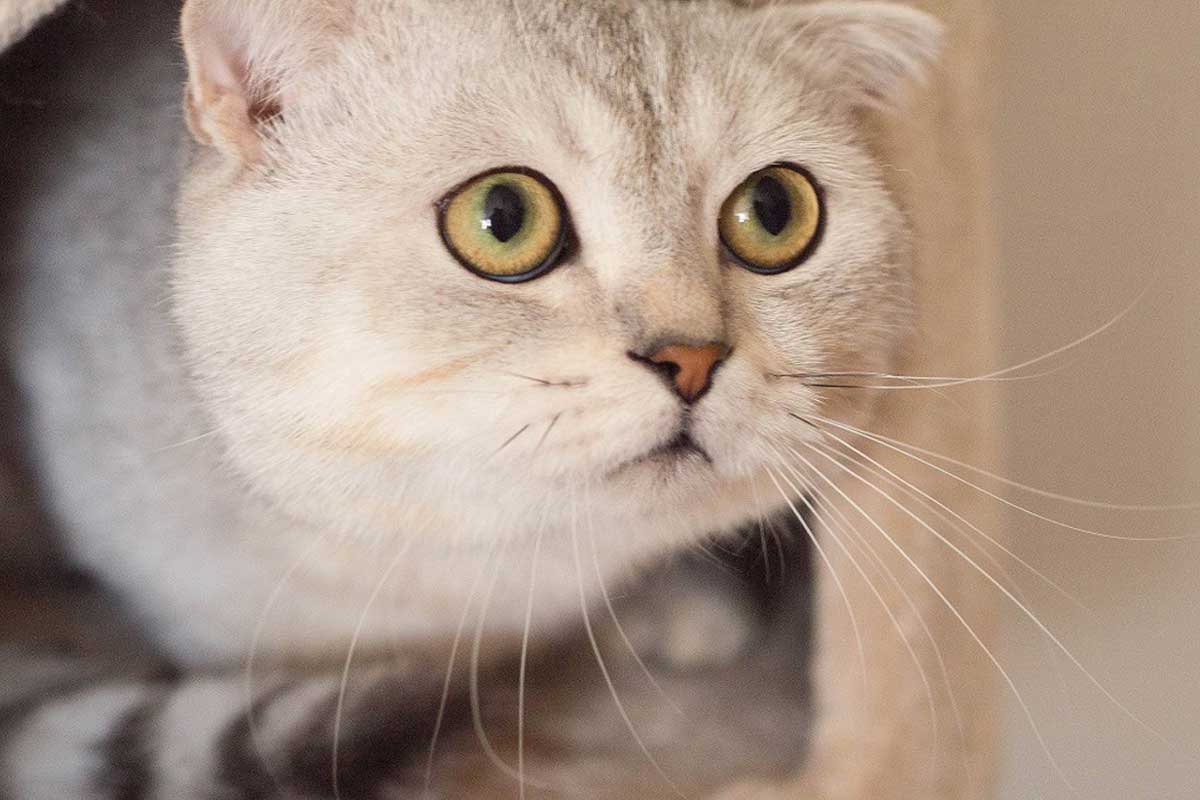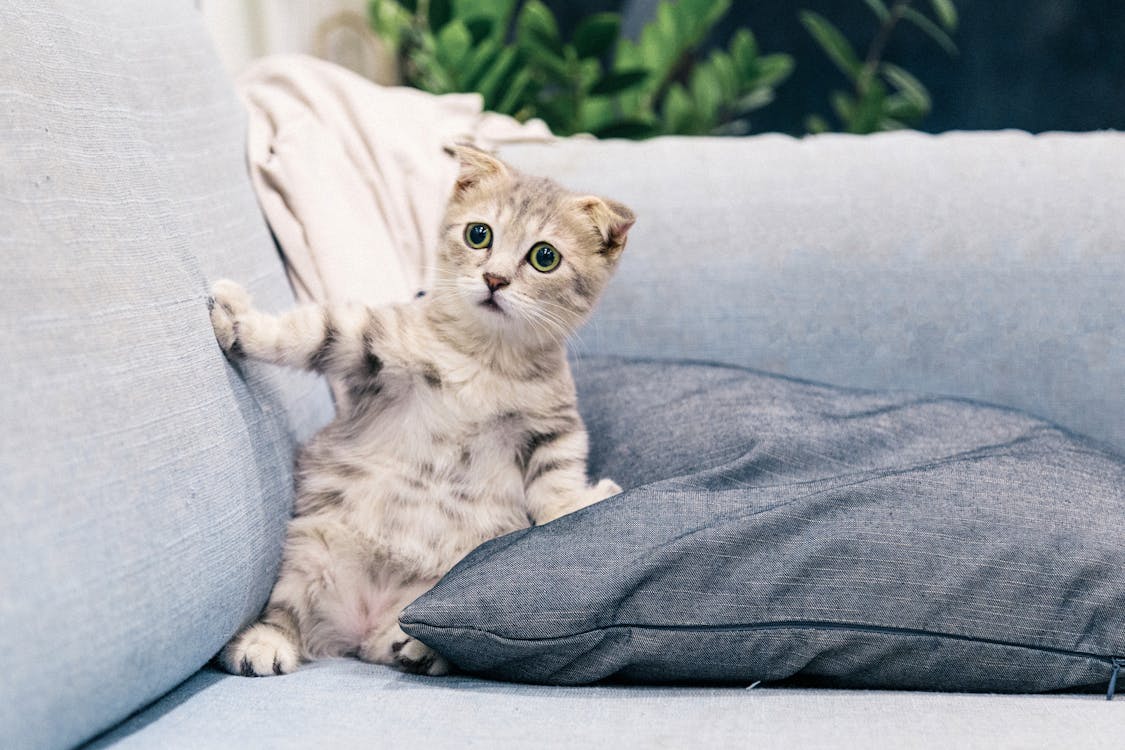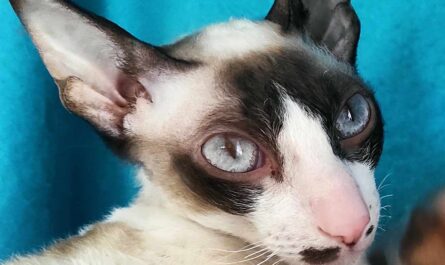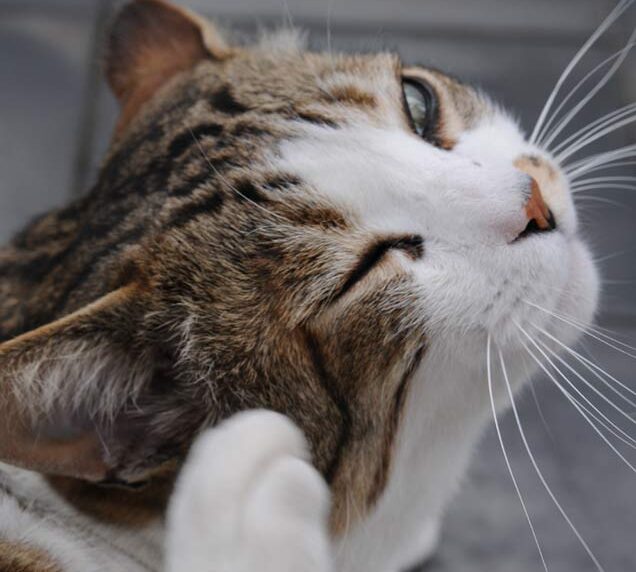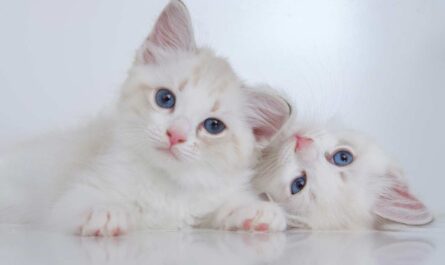How can play aggression in cats be effectively addressed?
Addressing play aggression in cats necessitates a nuanced understanding of their innate instincts. The key lies in providing outlets that channel their boundless energy and hunting prowess. Engaging in interactive play with thoughtfully chosen toys allows cats to express their natural behaviors—stalking, pouncing, and capturing. Crucially, steer clear of using hands or feet as unwitting play objects to dissuade the emergence of aggressive tendencies. By offering appropriate avenues for feline play, one transforms the landscape, fostering an environment where playfulness harmonizes with serenity.
What are suitable methods to calm down an aggressive cat?
Calming an aggressive cat becomes an art form, a delicate dance that revolves around creating an atmosphere steeped in tranquility. Pheromone diffusers, such as the renowned Feliway, emerge as silent orchestrators of relaxation, infusing the air with signals that appease the feline psyche. Craft a designated haven, complete with plush bedding, providing a retreat where your cat can find solace. And when the turbulent currents of aggression persist, the counsel of a veterinarian becomes invaluable—opening the door to the exploration of behavior-modifying medications, tailored to restore the elusive equilibrium.
How can one safeguard against an aggressive cat?
Safeguarding against an aggressive cat requires deciphering the subtle nuances of feline communication. A critical facet involves recognizing and respecting their boundaries, and steering clear of triggers that ignite aggressive responses. Sudden loud noises or swift movements are red flags to be avoided. When interacting with your feline companion, adopt an unhurried, gentle approach, allowing trust to blossom. Provide secluded hiding spots where they can gracefully retreat if the world becomes overwhelming. In this delicate dance, understanding the language of feline boundaries becomes the linchpin for fostering a bond where safety and mutual respect flourish.
What measures do veterinarians take when dealing with aggressive cats?
Veterinarians employ a multifaceted approach when confronted with aggressive cats during examinations. One prominent method involves the judicious use of sedation or the application of muzzles, ensuring not only the safety of the veterinary staff but also the well-being of the feline patient. These precautionary measures are pivotal, especially when dealing with cats exhibiting heightened anxiety or defensive behaviors.
In more intricate cases, veterinarians may delve into the realm of behavior modification plans. These bespoke strategies aim to address the root causes of aggression, going beyond mere symptom management. Additionally, the expertise of feline behavior specialists may be sought, offering a specialized and nuanced approach to understanding and alleviating the aggressive tendencies in cats. By adopting a comprehensive approach that combines physical safety measures with psychological interventions, veterinarians endeavor to create a conducive environment for both the feline patient and the healthcare providers.
What is considered the most effective medication for aggressive cats?
Determining the most effective medication for aggressive cats is a nuanced process that hinges on identifying the underlying causes of their aggression. Veterinary professionals often turn to a repertoire of medications, with anti-anxiety medications and antidepressants featuring prominently. These pharmacological interventions aim to modulate the cat’s behavior, addressing the emotional and psychological aspects contributing to aggression.
Crucially, the choice of medication is not a one-size-fits-all solution. It necessitates a personalized approach, wherein veterinarians carefully assess the individual needs and circumstances of the cat in question. Collaborative consultations between pet owners and veterinary experts become paramount in tailoring a medication regimen that not only curtails aggression but also promotes the overall well-being of the feline patient.
What might be the cause of sudden aggression in my cat?
The sudden onset of aggression in cats poses a mystifying challenge for pet owners and veterinarians alike. Unraveling this enigma requires a meticulous exploration of potential triggers, ranging from physical discomfort to emotional stressors. Pain, illness, fear, and environmental changes emerge as key players in the feline behavioral landscape.
To decode this puzzle, a thorough veterinary examination becomes indispensable. This comprehensive evaluation aims to rule out any underlying medical issues that might be fueling the cat’s aggression. Concurrently, a detailed assessment of the cat’s living environment helps identify stressors that may be contributing to the abrupt behavioral shift. Armed with this holistic understanding, veterinarians can craft tailored solutions, combining medical interventions with environmental modifications to restore harmony in the feline psyche.
Is it possible to cure aggression in cats?
Addressing aggression in cats necessitates a multifaceted approach, encompassing behavior modification, environmental adjustments, and, if deemed essential, medication. The quest for a complete “cure” hinges on meticulous identification and resolution of the underlying causes. Behavioral interventions may involve structured training sessions, employing positive reinforcement techniques to encourage desired behavior while discouraging aggression.
Environmental adjustments may encompass creating safe spaces, reducing stimuli that trigger aggression, and ensuring a stimulating environment to alleviate boredom. Medication, under the guidance of a veterinarian, might be considered in severe cases to help stabilize a cat’s behavior. It is paramount to tailor the intervention to the specific needs and triggers of the individual feline.
At what age do cats typically mellow down?
The trajectory of a cat’s demeanor follows a distinctive curve, with the most pronounced shifts occurring between the ages of 2 and 4. While this period marks a general trend toward mellowness, the feline world, like the human one, is replete with diversity. Individual variances mean that some cats may retain their lively and spirited nature well into their senior years, defying the conventional expectations of maturity.
The mellowing process, influenced by genetics and life experiences, encapsulates a spectrum rather than a universal timeline. Understanding and respecting these individual differences is pivotal for fostering harmonious relationships with our feline companions.
What are effective strategies for disciplining a cat?
Navigating the delicate task of disciplining a cat necessitates finesse and a nuanced understanding of feline psychology. Contrary to the outdated notion of punitive measures, positive reinforcement emerges as the cornerstone of effective discipline. Offering treats or affection as rewards for desirable behavior creates an associative link that encourages the repetition of such conduct.
Simultaneously, redirecting undesirable behavior with alternative activities prevents frustration or confusion in the cat. The resounding advice echoes against physical punishment, a method fraught with peril. Such actions can instill fear and provoke defensive aggression, undermining the trust crucial for a healthy human-cat relationship. In essence, disciplining a cat is an art that requires patience, consistency, and a keen appreciation for the intricacies of feline behavior.
How can the trust of an aggressive cat be earned?
Building a bond with an aggressive cat necessitates a delicate dance of patience and positive interactions. Begin by enticing the feline with irresistible treats, carefully chosen to cater to their palate.
Engage in playful activities that stimulate their instincts, gradually fostering a positive association with your presence. In addition to treats and play, embark on the gentle odyssey of petting, ensuring each stroke is a testament to your benevolence. Respect the enigmatic boundaries that shroud the cat’s disposition, allowing them the autonomy to initiate contact, gradually weaving a tapestry of security and trust.
What are practical ways to soothe a cat?
In the pursuit of serenity for your cat, fashioning a tranquil environment becomes a paramount consideration. Introduce cozy hiding spots, creating sanctuaries that cradle their senses in tranquility.
Beyond the physical realm, leverage the olfactory symphony of pheromone diffusers to imbue the surroundings with a calming aura. Elevate your approach with the sublime art of gentle petting or brushing, unraveling knots of tension with each stroke. Extend the auditory dimension by orchestrating the soothing melodies of calming music or the hushed whispers of white noise, crafting an auditory haven where anxiety surrenders to repose.
How do I prevent my cat from attacking its owner?
The perilous realm of a cat’s aggression demands a strategic roadmap for prevention. Delve into the labyrinthine understanding of feline triggers, deciphering the cryptic language of their sensitivities. Avoid sudden movements that may awaken the dormant beast within and handle it with a finesse befitting a maestro. Chart a course towards mental and physical stimulation through a repertoire of play and interactive toys, sating their predatory instincts in a controlled environment.
Should the specter of aggression persist, seek the sagacious counsel of a veterinarian or behavior specialist, unraveling the enigma that shrouds the feline psyche. Engage in a comprehensive exploration, peeling back the layers to reveal the intricate tapestry of causative factors, forging a bespoke approach to exorcise the shadows of hostility that linger in the feline soul.
Why would a cat suddenly become aggressive?
Abrupt changes in a cat’s behavior towards aggression can often be linked to an underlying medical condition or disease process. It becomes a perplexing puzzle for cat owners when feline companions, previously docile, suddenly display impulsive aggression with no apparent trigger or environmental cause. In some cases, the source of this unexpected hostility can be traced back to atypical occurrences like partial seizures within the limbic region. These seizures may manifest as impulsive aggression, leaving pet owners bewildered due to the absence of an observable trigger.
In situations where a cat, previously amiable to handling, undergoes a sudden shift towards aggression, it is advisable to promptly schedule a visit to the veterinarian. The abrupt behavior change could be a subtle signal of an underlying health issue, and a professional examination becomes imperative to unveil the mystery behind the cat’s unexpected aggression. The complexity of feline behavior requires a keen eye and a thorough examination to decipher the nuances of potential medical causes for such behavioral shifts.
What does it mean when your cat becomes aggressive?
When a cat exhibits aggression, it’s crucial to recognize that it might not be a standalone diagnosis but rather a behavioral sign hinting at an array of underlying factors. This behavioral manifestation is often rooted in the feline’s innate responses to fear, frustration, or distress caused by various stimuli. The source of aggression may extend beyond mere behavioral traits, delving into the cat’s emotional state. Fear stemming from unfamiliar stimuli, frustration due to inappropriate or prolonged handling, and distress when unable to escape a negative experience, such as at a vet clinic, are common triggers for aggressive behavior in cats.
Moreover, aggression can be a response to pain or external provocations, where the cat, unable to react immediately, redirects its hostility towards the owner or another pet in close proximity. Unraveling the mystery behind feline aggression requires a nuanced understanding of the cat’s emotional and physical state, with an acknowledgment that behavior is a complex interplay of various factors. It demands a comprehensive approach to identify and address the multifaceted triggers that may contribute to a cat’s sudden aggressive tendencies.
Do cats grow out of play aggression?
Play aggression is a common and often endearing behavior observed in kittens and highly active young cats, especially during specific times such as night-time, dawn/dusk, or feeding time. This behavior is often characterized by attention-seeking actions, including stalking, pouncing, and occasional playful attacks on humans. It’s a natural aspect of feline development and is particularly prominent in energetic and curious young cats.
However, this playful demeanor can take a problematic turn when cats feel bored or lonely. In such cases, they may engage in more intense stalking, pouncing, and even aggressive behavior if they perceive neglect or lack of regular playtime. The good news for cat owners is that, in many cases, cats tend to grow out of play aggression as their owners actively contribute to improving their lives. Techniques such as teaching kittens appropriate play using dangling toys instead of hands and feet, redirecting their attention to prey-like toys, incorporating interactive play with a feather wand, and introducing activities like leash walking and clicker training can all contribute to a positive transformation in a cat’s behavior.
How do you tell if your cats are playing or fighting?
Discerning between playful interactions and potential conflict among cats requires a keen understanding of their body language and vocalizations. During play sessions, affiliated cats will engage in activities such as chasing, stalking, pouncing, and striking each other with their paws. Playful encounters are typically silent, with cats wrestling and spending equal time rolling onto their sides or backs. Even gentle biting may occur without causing injury or pain. Cat accessories on Amazon
In contrast, defensive aggression during non-play interactions is marked by a cat adopting a protective posture—crouching, shunning the perceived threat, flattening ears, tucking the head, and raising hackles. Hissing and growling are common vocalizations in defensive aggression. On the other hand, offensive aggression is characterized by a threatening posture, with a cat stiffening its legs, exhibiting piloerection, staring, moving towards the target with a rigid tail, and vocalizing through long meows and growls. Identifying these subtle cues helps cat owners differentiate between harmless play and potentially aggressive encounters, allowing for timely interventions and harmonious coexistence among feline companions.
How do you balance your cat’s playing or fighting?
Creating a conducive environment for feline companionship involves not only understanding the nuances of play aggression but also actively participating in shaping positive interactions. As owners, redirecting a cat’s playful instincts towards appropriate outlets and engaging in regular interactive play sessions are crucial elements in fostering a healthy relationship. The introduction of stimulating activities like leash walking and clicker training adds variety to a cat’s routine, contributing to mental and physical well-being. See why thousands of cats love BoxCat
Ensuring a sense of balance and playfulness is essential in mitigating potential conflicts among cats. Observing their behavior during play, noting the absence of aggressive vocalizations, and ensuring an overall joyful demeanor can provide insights into the positive nature of their interactions. Through a combination of proactive play management, understanding feline communication, and providing a stimulating environment, owners can cultivate a harmonious and enriching relationship with their feline companions.
Final thought: Navigating the Complex Realm of Feline Aggression
In conclusion, any form of feline aggression poses a significant challenge for pet owners. Whether rooted in fear, frustration, misdirected play, or underlying illness, understanding and addressing aggression necessitate a multifaceted approach. Behavioral and environmental modifications can often ameliorate various types of aggression, but a thorough veterinary examination remains crucial to rule out medical conditions.
Given the complexity of feline aggression, seeking professional guidance from a Qualified Animal Behaviorist is paramount. These experts can craft customized treatment plans tailored to a feline companion’s unique needs, ensuring a harmonious coexistence between pets and their human caregivers.
